Centauri Dreams
Imagining and Planning Interstellar Exploration
A Manifesto for Expansion
Michael Michaud gave the speech that follows in 1988 at the 39th International Astronautical Congress, which met in Bangalore, India in October of that year. Reading through it recently, I was struck by how timely its theme of spaceflight advocacy and human expansion into the cosmos remains today. When he wrote this, Michaud was director of the Office of Advanced Technology for the US Department of State, though he reminded his audience that the views herein were his own and not necessarily those of the US government. Michaud’s support of spaceflight and his determinedly long-term approach to our possibilities as a species has distinguished his space writing, which has been prolific and includes the essential Contact with Alien Civilizations
by Michael A.G. Michaud
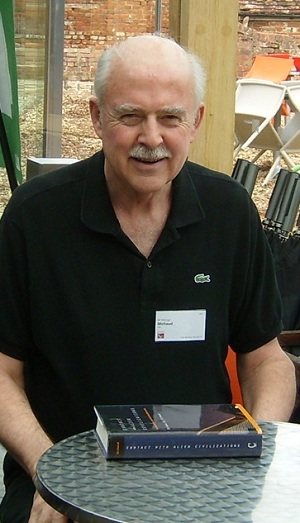
The history of astronautics is not only a history of scientific and technological progress, but is also a history of persuasion. Advances in astronautics have sprung not only from steady technical advance, but also from advocacy, led by individuals and groups with deep-seated motivations. Those advocates, while often frustrated in the near term, laid the philosophical and cultural foundations that helped speed the coming of the Space Age.(1)
While many justifications have been put forward for space activities, two motivations have consistently underlain the leading edge of the space advocacy: the exploration of the universe around us, and human expansion into it. Throughout the history of astronautics, other motivations have appeared and disappeared, but these two always have been identifiable.
The Spaceflight Advocacy
The Spaceflight advocacy began with visions and ideas, initially in science fiction. Serious theoretical work began with Konstantin Tsiolkovski in the late l9th and early 20th centuries. Hermann Oberth and Robert Goddard further developed the theoretical structure necessary for spaceflight. Initial rocket experiments were conducted by Goddard and others in the United States, by members of the Verein Fur Raumschiffahrt in Germany, and by members of rocket societies in the Soviet Union. The VFR in Germany, the American Interplanetary Society in the United States, and the British Interplanetary Society were advocating interplanetary travel in the early l930’s. Yet rockets of significant scale were not launched until World War II. Despite far-seeing work such as the 1946 RAND study(2), the use of the rocket to enter space had little political support in the 1940s. Yet, a decade later our machines had entered space to stay, and two decades later we landed humans on the Moon.
The original space advocacy, directed toward exploration and expansion beyond the Earth’s atmosphere into cislunar space and later into the solar system, has been spectacularly successful. By 1989, our unmanned spacecraft will have visited every planet in our solar system except Pluto. Both the Soviet Union and the United States — with its allies — are establishing a permanent human presence in low Earth orbit. The industrialization of near-Earth space has been conceptualized since the early 1970s, and the idea of human colonies in free space has been shown to be technically feasible. Advocacies have crystallized around the long-visualized Moon Base and manned mission to Mars; though neither goal has been achieved yet, it is widely expected that both will be early in the 21st century. The U.S. National Commission on Space has proposed an elaborate space transportation infrastructure linking the Earth to the Moon and Mars.(3) We are well advanced in exploring the solar system, and are close to expanding into it.
A major symbolic turning point occurred in February, 1988, with the release of a new U.S. national space policy document. That document committed the United States to a new long-term goal: the expansion of human presence and activity beyond Earth orbit into the solar system.(4) This had been a goal of the spaceflight advocacy for many years, identifiable implicitly in the writings of Tsiolkovski and explicitly at least as far back as the 1920s. In two to three generations (depending on the starting point one chooses), the spaceflight advocacy had won a policy endorsement that would have seemed inconceivable to any but its most optimistic original members: the expansion of the human species outward from Earth.
The Interstellar Advocacy
In recent years, we have seen a small but active advocacy for interstellar flight. In many ways, the interstellar advocacy of today is similar to the spaceflight advocacy of the 1920s and the 1930s. Dedicated and believing that what it advocates is not only right but inevitable, the members of that advocacy are doing the theoretical work and are laying out plans for interstellar exploration and travel. However, they lack the credibility needed to win funding and political support for their proposals.
Like the spaceflight advocacy, the interstellar advocacy first appeared in science fiction, in the 1930s and 1940s. The first significant non-fiction paper was published in 1950.(5) Scattered works appeared during the next two decades, but it was not until the mid-1970s that the interstellar advocacy achieved some public recognition. Landmarks were Forward’s paper “A National Program for Interstellar Exploration,” published in 1975, and the British Interplanetary Society’s Project Daedalus study, published in 1978.(6) Papers on the theory and technology of interstellar flight began to appear more frequently, particularly in Astronautica Acta and the interstellar studies issues of the Journal of the British Interplanetary Society. The literature grew to the point that bibliographies were published.(7) Yet the number of advocates remains small, the literature still is specialized and narrowly circulated, and political and financial support is essentially non-existent.
The interstellar advocacy has reflected both the motivation to explore our larger environment and the motivation to expand human presence and activity beyond our solar system. Many of the proposed missions, particularly the early ones, are unmanned probes of nearby star systems. Others are missions of manned exploration, and still others are explicitly intended to carry human colonists to other systems, beginning the human colonization of the galaxy. None of these missions are known to be on the agenda of any space agency. However, more modest precursor missions have been proposed, such as an extrasolar probe, an Oort cloud mission, or the Thousand Astronomical Unit probe, which are extensions of existing solar system exploration technology.
In its 1988 report titled Space Science in the 21st Century, the Space Science Board of the U.S. National Academy of Sciences endorsed an interstellar probe. The Board envisioned a spacecraft that would escape the solar system at a velocity of about 80 kilometers a second, and enter the interstellar medium within 10 years. Such a spacecraft, if launched in the year 2000, would pass the Pioneer and Voyager spacecraft new proceeding slowly toward the stars.(8) This endorsement would have been inconceivable only a decade earlier.
The interstellar advocacy is not yet taken seriously by the opinion leaders of any nation, and has yet to win support from any government. That advocacy might do well to reflect on the history of the successful spaceflight advocacy, which took decades to sell its ideas, and only won success in stages. Its progress was not smooth, but was marked by raised hopes and disappointments, starts and stops. Political events and cultural change had significant impacts on the process. The advocacy could not force events beyond what was known of the physical environment and foreseeable technology at any given time. Yet it succeeded in transferring its aspirations to many people, and in eroding conceptions of what was not possible in others. Many of its views have been adopted by the governments of major nations, and are part of popular culture.
The Larger Context
Both the spaceflight advocacy and the interstellar advocacy reflect larger paradigms of human exploration and expansion.(9) We humans, who have explored and expanded into new environments on Earth, have nearly completed our initial reconnaissance of the solar system, and are on the verge of expanding into it. The day may come when we find the solar system as limiting to our aspirations as the Earth was thirty years ago. We will look outward into an even larger environment, sprinkled with stars and planetary systems. We will explore the nearer parts of the interstellar environment through space-based astronomy and unmanned probes. Then, with our improved knowledge of that environment, our improved technological capabilities, our expanded economic base, and our changed point of view, we may choose to continue the expansion. With that decision, we will assure that humans and their cultures will free themselves of dependence on one star, as they are now freeing themselves of dependence on one planet,
This vision will not be accepted easily by the public — even the informed public. While some individuals accept the outward-looking paradigms of exploration and expansion, most do not, and must be persuaded in stages to at least tolerate such ventures. If the advocacy of interstellar exploration and colonization is to succeed, it must have a long perspective, and must maintain a certain degree of continuity. Yet it also must be ready to seize on events that will speed the coming of interstellar flight. In doing so, it will demonstrate a continuity with the spaceflight advocacy that rests on the shared aspirations of exploration and expansion.
A Manifesto
Humanity should adopt expansion beyond Earth as a major organizing theme for its future. Evidence is strong that life tends to expand into new ecological niches when that is possible, and that such expansion is advantageous for the species. Expansion opens new opportunities for evolution and diversification, and for access to larger resources of materials and energy. Space is the macro-environment for life, the ultimate extension of our ecological range.
Exploration precedes expansion. Even more than the other forms of life we know, humans are motivated to expand by their improving perceptions of their larger environment. They deliberately explore the larger environment of space in the belief that they will benefit from improved knowledge. Astronomy and the unmanned exploration of space are allies of human expansion.
We should be conceptualizing the expansion in stages. The rate of human expansion is constrained by our perceptions, by our technologies, by our economic and human resources, and by our cultures, particularly by the predominant conceptions of what is possible. While there is a growing perception that a permanent human presence on the Moon and the human exploration of Mars are feasible, the creation of a solar system civilization still seems beyond our reach. In the early stages of developing a solar system civilization, we may reject the idea of human interstellar flight: later, with an expanded economic and technical base and greater confidence in our abilities, interstellar voyages will seem more feasible. Each stage will grow from the perceptions and capabilities created in the preceding stage.
Humanity needs to develop the technologies of expansion. Humans dreamed of voyages beyond the Earth for centuries, but could not accomplish those dreams until the technologies of the 20th century made them possible. Without telescopes, we would not have been tantalized by Mars; without rocketry, we could not have seen it in detail; without improved life support systems, we will not be able to journey there ourselves. Technology enables expansion.
Expanding into the Galaxy is an appropriate long-term goal for humanity. To rise above their intra-species disputes, humans need purposes that transcend their divisions. The expansion of humanity outward from the Earth and later outward from our solar system would be a grand shared enterprise for humanity, extending over many generations and giving us a long-term continuity of purpose.
Human expansion will require a continuity of intelligent advocacy. While the drive to expand is strong, cultural values vary with time and place, and the degree of support for expansion will vary with them. At each stage of the expansion there will be arguments against the next stage, which will be called too expensive or impractical; there also may be arguments against expansion because of our own moral imperfection. Advocates will be needed at every stage.
Conclusion
Astronautics already has brought great benefits to humanity, in our ability to communicate with each other, to navigate safely, to preserve the peace, to observe the Earth and the atmosphere, to study the solar system, the Galaxy and the Universe, and to perceive of ourselves as a species. Implicit in astronautics is the idea of expansion, which will bring benefits we can only dimly perceive today. Some have sensed all along that astronautics is linked to our destiny as a species.
We who are advocates of spaceflight, of interplanetary flight, and of interstellar flight are part of a great continuity. We are expressions both of powerful human drives and of an intellectual tradition. We have an endless mission before us, one marked by a succession of stages in which resistance, doubt, and delay must be overcome. Now that the first Spaceflight Revolution is behind us, we have reached a stage of maturity in which we can consciously decide and declare our intent to be human expansionists. We should not be embarrassed to be advocates of human expansion; we should be proud.
——-
References
1. For studies of the spaceflight advocacy, see William S. Bainbridge, The Spaceflight Revolution, New York, John Wiley and Sons, 1976; Frank H. Winter, Prelude to the Space Age: The Rocket Societies, 1924-1940, Washington, D.C., Smithsonian Institution Press, 1983; Michael A.G. Michaud, Reaching for the High Frontier: The American Pro-Space Movement, 1972-1984, New York, Praeger, 1986.
2. Report Number SM-11827, Preliminary Design of an Experimental World-Circling Spaceship, May, 1946.
3. National Commission on Space, Pioneering The Space Frontier, New York, Bantam, 1986.
4. White House Fact Sheet on Presidential Directive on National Space Policy, February 11, 1988.
5. Leslie R. Shepherd, “Interstellar Flight,” Journal of the British Interplanetary Society, Volume 11 (1950), Pages 149-55.
6. Robert L. Forward, “A National Program for Interstellar Exploration,” in Future Space Programs 1975, a compilation of papers prepared for the Subcommittee on Space Science and Applications of the Committee on Science and Technology of the U.S. House of Representatives, Volume II, Washington, D.C., U.S. Government Printing Office, 1975, pages 279-326; Project Daedalus: The Final Report on the BIS Starship Study, supplement to the Journal of the British Interplanetary Society, 1978.
7. For example, see Eugene F. Mallove, Robert L. Forward, Zbigniew Paprotny, and Jurgen Lehmann, “Interstellar Travel and Communication: A Bibliography,” Journal of the British Interplanetary Society, Volume 33 (1980), entire issue.
8. Space Science Board, Space Science in the Twenty-First Century: Imperatives for the Decades 1995 to 2015 — Overview, Washington, D.C., National Academy Press, 1988, page 34.
9. For further elaborations by this author on the theme of human expansion, see Michael A.G. Michaud, “Spaceflight, Colonization, and Independence,” Journal of the British Interplanetary Society, Volume 30, Number 3 (March, 1977), 83-95 (Part One); volume 30, Number 6 (June, 1977), 203-212 (Part Two); Volume 30, Number 9 (September, 1977), 323-331 (Part Three); Michael A.G. Michaud, “The Extraterrestrial Paradigm,” Interdisciplinary Science Reviews, Volume 4, Number 3 (September, 1979), 177-192; Michael A.G. Michaud, “Four-Dimensional Strategy,” in Jerry Grey and Christine Krop, Editors, Space Manufacturing Facilities 3: Proceedings of the Fourth Princeton /AIAA Conference, New York, American Institute of Aeronautics and Astronautics, October 31, 1979, 49-61; Michael A.G. Michaud, “Improving the Prospects for Life in the Universe,” in William A. Gale, Editor, Life in the Universe: The Ultimate Limits to Growth, Boulder, Colorado, Westview, Press, 1979, 107-117.

The Milky Way from a Distance
Growing up in the American Midwest, I used to haunt the library in Kirkwood, Missouri looking for books on astronomy. I had it in mind to read all of them and I pretty much did, looking with fascination at fuzzy images of distant objects I yearned to see close up. What did Saturn look like from Titan? What would it be like to be close enough to see the Crab Nebula fill the sky? Breathtakingly, what would it look like to be inside one of the great globular clusters?
Early on in Vernor Vinge’s A Fire Upon the Deep the character Ravna finds herself looking out a window at the entire Milky Way from a distance sufficient to view it whole:
She’d guessed right: tonight the Galaxy owned the sky… Without enhancement, the light was faint. Twenty thousand light-years is a long, long way. At first there was just a suggestion of mist, and an occasional star. As her eyes adapted, the mist took shape, curving arcs, some places brighter, some dimmer. A minute more and … there were knots in the mist … there were streaks of utter black that separated the curving arms … complexity on complexity, twisting toward the pale hub that was the Core. Maelstrom. Whirlpool. Frozen, still, across half the sky.
When I read that, all I could think was that I’d like to know what Chesley Bonestell would have done with the scene. The memory stuck with me, enough so that last weekend, I went digging through my collection of old magazines in search of a particular cover. We had been talking on Centauri Dreams about a Poul Anderson story called World Without Stars, and having been reminded of it by several readers, I kept thinking it was in a 1960s era Analog, and that Bonestell had indeed done a cover showing the Milky Way.
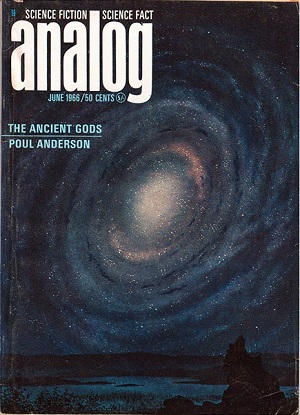
Soon I had magazines spread all over my office floor but couldn’t put my hands on the right one. The problem was that while I remembered (vaguely) the plot, about a crew that found itself tens of thousands of light years outside the galaxy on a mission to an isolated technical civilization, I had forgotten the original title. Finally I did the obvious and ran World Without Stars through the Internet Speculative Fiction Database, where I found the issue numbers. It turns out the story was serialized in Analog’s June and July, 1966 issues as The Ancient Gods, and my memory of a Chesley Bonestell cover was correct.
But serendipitous things happen when you collect old magazines. In leafing through the June issue, I came across a letter Poul Anderson had written to John Campbell, then in the latter part of his long run at the magazine — Campbell published it in Brass Tacks, his letter column, even though it was really just directed at the editor. Anderson talks about having been at Bonestell’s place and seeing the cover art for The Ancient Gods.
Did you notice in the Vinge paragraph above how dim the galaxy is depicted as being? Ravna thinks to herself that 20,000 light years is a long way out, and Anderson’s crew was to be a lot further out than that. Bonestell had been thinking all this over and had to find a way to work it into his painting. Thus Anderson to Campbell in the letter:
One point came up which may interest you. Though the galaxy would be a huge object in the sky, covering some 20? of arc, it would not be bright. In fact, I make its luminosity, as far as this planet is concerned, somewhere between 1% and 0.1% of the total sky-glow (stars, zodiacal light, and permanent aurora) on a clear moonless Earth night. Sure, there are a lot of stars there — but they’re an awfully long ways off!
If you look at the Bonestell cover, it does appear to be glowing more brightly than this, but Anderson says this is not a contradiction. His imagined planet’s natives, he points out, are adapted to the dim light of the red dwarf they orbit (no tidal lock here, evidently), and the galaxy in their night would appear luminous enough. Anderson adds: “To us, galaxies look brilliant in an astronomical photograph — but that picture involved a huge light-gathering mechanism plus hours of exposure. We could make the Milky Way look just as bright if we wanted to.”
Anyway, Bonestell had to come up with something that would be bright enough to be interesting while still suggesting the distances involved, and he certainly manages this. For the humans who have just landed on this remote world, the galaxy at 200,000 light years out is indeed a dim spectacle, as described in the story:
This evening the galaxy rose directly after sunset. In spite of its angular diameter, twenty-two degrees along the major axis, our unaided eyes saw it ghostly pale across seventy thousand parsecs. By day it would be invisible. Except for what supergiants we could see as tiny sparks within it, we had no stars at night, and little of that permanent aurora which gives the planets of more active suns a sky-glow.
And later:
Vast and beautiful, it had barely cleared the horizon, which made it seem yet more huge. I could just trace out the arms, curling from a lambent nucleus… yes, there was the coil whence man had come, though if I could see man by these photons he would still be a naked half-ape running the forests of the Earth…
Keep going further out and galaxies tend to all but disappear. Greg Laughlin noted this back in 2005 on his systemic site, where he discussed the beauty of objects like M104, the Sombrero Galaxy, which seen from a distance a bit further than Anderson’s 200,000 light years, would appear as “only a faintly ominous, faintly glowing flying saucer.” M31, the great Andromeda galaxy, is larger than the full Moon in the sky, but go out tonight and try to find it. Laughlin adds: “Our Galaxy, the Andromeda Galaxy, and the Sombrero Galaxy are all essentially just empty space. To zeroth, to first, to second approximation, a galaxy is nothing at all.”
More power, then, to long CCD time exposures and big mirrors, allowing us to see the things our eyes would perceive only dimly. Part of the thrill of those early library days was in looking at spectacular objects and trying to imagine them close up. But it was a thrill of equal measure to begin to learn about the wavelengths of light, about the gathering of photons, and the way we can tease out information about the universe with instruments designed to surmount our limitations.

Fritz Zwicky On Moving Stars
The great Ukrainian mathematician Israil Moiseyevich Gelfand was famous for his weekly seminars in Moscow, where sudden switches in topics and impromptu presentations were the norm. Although his listeners had heard it many times, Gelfand liked to tell this story: In the early 20th Century, a man approaches a physicist at a party and says he can’t understand how the new wireless telegraphy works. How is it possible to send a signal without using wires?
The physicist tells him it is simple. “To understand wireless telegraphy, you must first understand how the wired telegraph system works. Imagine a dog with its head in London and its tail in Paris. You yank the tail in Paris and the head in London barks. That is wired telegraphy. Wireless telegraphy is the same thing except without the dog.”
It always got Gelfand a laugh, but he liked to use the story for a deeper purpose. According to Edward Frenkel, who in his youth attended and presented at some of Gelfand’s seminars, Gelfand would use the tale whenever he thought a problem needed a more radical solution than anyone had proposed. “What I am trying to say,” he invariably added, “is that we need to do it without the dog.” Read Frenkel’s charming Love & Math: The Heart of Hidden Reality (Basic Books, 2013) for a look at Soviet-era mathematicians and the world they worked in.
I’m thinking that if there was ever a man who worked without the dog, it was Fritz Zwicky (1898-1974). The name of the Bulgarian-born physicist who spent his career in the United States inevitably came up in the light of our discussions on moving entire stars. This was a man with a deeply independent mind whose six-volume catalog of 30,000 galaxies, based on the Palomar Observatory Sky Survey, remains a touchstone in the study of galaxy clusters. But he was also a thorn in the side of many astronomers, routinely disparaging their work and their characters.

If a combative colleague — he coined the term ‘spherical bastards’ to describe his fellow astronomers, who he said were bastards from any angle you chose to observe them — Zwicky was kind to students, university administrators and people outside his profession. He was a man who liked to think big. Zwicky broached the subject of what we might call ‘stellar propulsion’ in a May, 1948 lecture at Oxford University, where he said there was a possibility of:
“…accelerating…[the Sun] to higher speeds, for instance 1000 km/s directed toward Alpha Centauri A in whose neighborhood our descendants then might arrive a thousand years hence. [This one-way trip] could be realized through the action of nuclear fusion jets, using the matter constituting the Sun and the planets as nuclear propellants.”
Zwicky’s lecture was published later that year in The Observatory (68:121-143). In a June, 1961 article in Engineering and Science called “The March Into Inner and Outer Space,” he followed up on the idea, although as before only in broad terms shorn of detail. In Zwicky’s view, a journey to the stars should not necessarily demand leaving the Earth behind. Instead, accelerate the Sun, letting it pull the planets along with it, and you maintain your own environment on the most comfortable of all generation ships. As to how to do it:
In order to exert the necessary thrust on the sun, nuclear fusion reactions could be ignited locally in the sun’s material, causing the ejection of enormously high-speed jets. The necessary nuclear fusion can probably best be ignited through the use of ultrafast particles being shot at the sun. To date there are at least two promising prospects for producing particles of colloidal size with velocities of a thousand kilometers per second or more. Such particles, when impinging on solids, liquids, or dense gases, will generate temperatures of one hundred million degrees Kelvin or higher-quite sufficient to ignite nuclear fusion. The two possibilities for nuclear fusion ignition which I have in mind do not make use of any ideas related to plasmas, and to their constriction and acceleration in electric and magnetic fields.
Zwicky would amplify his stellar propulsion ideas in his book Discovery, Invention, Research through the Morphological Approach (Macmillan, 1969), where he described how these directed exhaust jets would accelerate the Sun to a velocity sufficient to reach Alpha Centauri in about fifty human generations. Left for the reader’s imagination is the question of how a moving Solar System would decelerate once it arrived in the vicinity of the Alpha Centauri stars, presumably to join them to form a new triple (or quadruple, counting Proxima Centauri) star system.
We’ve seen how Leonid Shkadov conceived of wrapping a thruster around a star in such a way as to create propulsive forces, an idea now explored in the Greg Benford and Larry Niven novels Bowl of Heaven and Shipstar. But it’s clear that a star journey via a propulsive Sun is yet another idea that Zwicky had early, although he never went ahead to work out all the ramifications. In addition to manipulating the Sun’s own fusion, Zwicky’s Engineering and Science article described other broad concepts: The benefits of taming fusion for power and rocket propulsion, the need for a human presence in nearby space, particularly the Moon, and the possibility of using what he called ‘terrajet engines’ to burrow into the interior of the Earth.
In tribute to Zwicky, it’s necessary to mention several of his insights, including the notion that cosmic rays are produced in the explosion of massive stars which he began, in 1931 lectures, to describe as ‘supernovae,’ as opposed to the more common and less powerful novae. Working with Mount Wilson Observatory astronomer Walter Baade, he went on to extrapolate the creation of neutron stars that were dense as atomic nuclei but only a few kilometers in diameter, an idea that was met with skepticism.
The Palomar Observatory Sky Survey grew out of Zwicky’s work, and Zwicky himself discovered 122 supernovae. But his work hardly ended with exploding stars. Investigating the Coma cluster of galaxies, he worked out that the mass of the cluster was far too little to produce the gravitational forces needed to keep the cluster together. Unseen matter — and he coined the term ‘dark matter’ — must be making up the difference in mass. How to investigate the idea? Zwicky suggested gravitational lensing, now a common technique but a novel solution in his day.
In his dark matter work in particular, Zwicky can be said to have done what Israil Moiseyevich Gelfand urged. He learned how to do it without the dog, to take an enormous conceptual leap into an answer that later observation would prove suggestive and worthy of intense follow-up. He was a stormy genius, an irritated, irritating treasure of a man.

Building the Bowl of Heaven
Because his new novel Shipstar had just reached the top of my reading stack, and because I had been writing about Shkadov Thrusters last week, I asked Gregory Benford if he could provide a deeper explanation of how these enormous structures might work. Greg had already noted in an email to me that a Shkadov Thruster is inherently unstable, and earlier discussions of the idea on Centauri Dreams had raised doubts about the acceleration possible from such a device. However, I’ve referred to what Benford and Larry Niven have created as a ‘modified’ Shkadov Thruster, and I was anxious to hear their thinking on what might be possible. Greg, an award-winning science fiction author and physicist, here offers his insights into — and reservations about — a propulsion scheme capable of moving stars.
by Gregory Benford
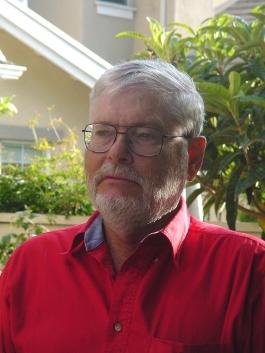
Physicist Leonid Shkadov first described in 1987 a stellar propulsion system made by putting an enormous mirror in a static, fixed position near a star. To stay there it had to balance gravitational attraction towards and light pressure away from the star, exactly—or else it would either fall into or away from the star. Since the radiation pressure of the star would be asymmetrical, i.e. more radiation is being emitted in one direction as compared to another, the excess radiation pressure acts as net thrust, so tiny that the Sun would, after a million years, have speed of 20 m/s, and have moved 0.03 light years—far less than its orbital speed around the galaxy, ~100 km/sec.
Surely we can do better, I thought back in the early 2000s. So I mentioned some ideas to Larry Niven, and eventually we wrote two novels about a different sort of stellar thruster — Bowl of Heaven and Shipstar. Here’s an explanation from the Afterword to Shipstar:
We think of such engines as Smart Objects–statically unstable but dynamically stable, as we are when we walk. We fall forward on one leg, then catch ourselves with the other. That takes a lot of fast signal processing and coordination. (We’re the only large animal without a tail that’s mastered this. Two legs are dangerous without a big brain or a stabilizing tail.) There’ve been several Big Dumb Objects in sf, but as far as I know, no smart ones. Our Big Smart Object is larger than Ringworld and is going somewhere, using an entire star as its engine.
Our Bowl is a shell more than a hundred million miles across, held to a star by gravity and some electrodynamic forces. The star produces a long jet of hot gas, which is magnetically confined so well it spears through a hole at the crown of the cup-shaped shell. This jet propels the entire system forward – literally, a star turned into the engine of a “ship” that is the shell, the Bowl. On the shell’s inner face, a sprawling civilization dwells. The novel’s structure doesn’t resemble Larry’s Ringworld much because the big problem is dealing with the natives.
The virtue of any Big Object, whether Dumb or Smart, is energy and space. The collected solar energy is immense, and the living space lies beyond comprehension except in numerical terms. While we were planning this, my friend Freeman Dyson remarked, “I like to use a figure of demerit for habitats, namely the ratio R of total mass to the supply of available energy. The bigger R is, the poorer the habitat. If we calculate R for the Earth, using total incident sunlight as the available energy, the result is about 12 000 tons per Watt. If we calculate R for a cometary object with optical concentrators, travelling anywhere in the galaxy where a 0 magnitude star is visible, the result is 100 tons per Watt. A cometary object, almost anywhere in the galaxy, is 120 times better than planet Earth as a home for life. The basic problem with planets is that they have too little area and too much mass. Life needs area, not only to collect incident energy but also to dispose of waste heat. In the long run, life will spread to the places where mass can be used most efficiently, far away from planets, to comet clouds or to dust clouds not too far from a friendly star. If the friendly star happens to be our Sun, we have a chance to detect any wandering life-form that may have settled here.”
This insight helped me think through the Bowl, which has an R of about 10-10!
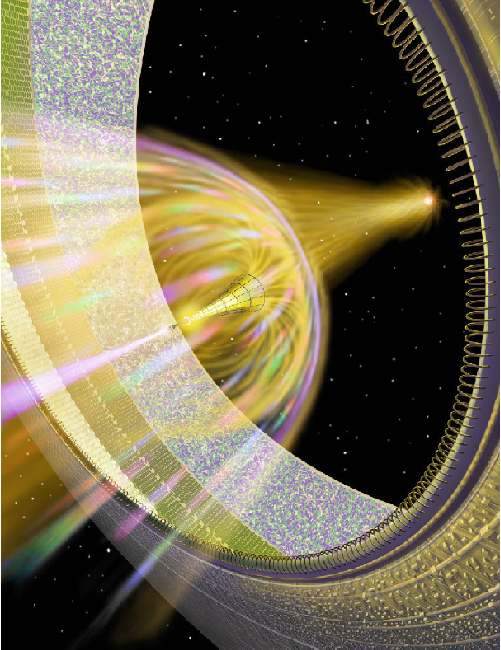
Image: Artwork by Don Davis, as are all the images in this essay.
Stability
Shdakov thrusters aren’t stable. They are not statites, Bob Forward’s invention, because they’re not in orbit. Push them, as the actual photon thrust will do, and they’ll fall outward, doomed. So how to build something that harvests a star’s energy to move it and can be stabilized?
I worried this subject, and thought back to the work my brother Jim and I had done on speeding up sails by desorption of a “paint” we could put onto a sail surface, to be blown off by a beam of microwave power striking it. This worked in experiments we did at JPL under a NASA grant, with high efficiency. Basically, throwing mass overboard is better than reflecting sunlight, because photons have very little momentum. The ratio of a photon’s momentum to that of a particle moving at speed V is
(V/c)(2Ep )/EM
where Ep is the photon energy and EM the kinetic energy of the mass M. So if those two energies are the same, the photon has a small fraction of the mass’s momentum, V/c.
So don’t use photons. Use a jet of the mass brought out from the star by forcing it to eject a jet—straight through the center of the Bowl. Jets must be confined by magnetic fields, or else they spray outward like a firehose. Get the magnetic fields from where the reflecting band of mirrors on the Bowl focuses it—on the nearest part of the star. Create a jet from that reflected energy. Make the jet push the star away. Use the jet’s magnetic fields to entwine with fields built into the Bowl itself. Let the jet hug the Bowl toward the star. Only by shaping the magnetic fields of star and jet can we move the Bowl, with constant attention to momentum and stability.
Stable, if you manage it. Who does that? How?
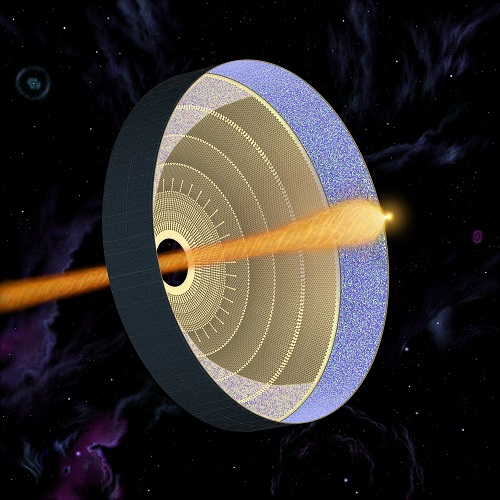
Larry Niven and I started building the Bowl in our minds:
The local centrifugal gravity avoids entirely the piling up of mass to get a grip on objects, and just uses rotary mechanics. So of course, that shifts the engineering problem to the Bowl structural demands.
Big human built objects, whether pyramids, cathedrals, or skyscrapers, can always be criticized as criminal wastes of a civilization’s resources, particularly when they seem tacky or tasteless. But not if they extend living spaces and semi-natural habitat. This idea goes back to Olaf Stapledon’s Star Maker: “Not only was every solar system now surrounded by a gauze of light traps, which focused the escaping solar energy for intelligent use, so that the whole galaxy was dimmed, but many stars that were not suited to be suns were disintegrated, and rifled of their prodigious stores of sub-atomic energy.”
Our smart Bowl craft is also going somewhere, not just sitting around, waiting for visitors like Ringworld–and its tenders live aboard.
We started with the obvious: Where are they going, and why?
Answering that question generated the entire frame of the two novels. That’s the fun of smart objects – they don’t just awe, they intrigue.My grandfather used to say, as we headed out into the Gulf of Mexico on a shrimping run, A boat is just looking for a place to sink.
So heading out to design a new, shiny Big Smart Object, I said, An artificial world is just looking for a seam to pop.
You’re living just meters away from a high vacuum that’s moving fast, because of the Bowl’s spin (to supply centrifugal gravity). That makes it easy to launch ships, since they have the rotational velocity with respect to the Bowl or Ringworld… but that also means high seam-popping stresses have to be compensated. Living creatures on the sunny side will want to tinker, try new things…
“Y’know Fred, I think I can fix this plumbing problem with just a drill-through right here. Uh—oops!”
The vacuum can suck you right through. Suddenly you’re moving off on a tangent at a thousand kilometers a second—far larger than the 50 km/sec needed to escape the star. This makes exploring passing nearby stars on flyby missions easy.
But that easy exit is a hazard, indeed. To live on a Big Smart Object, you’d better be pretty smart yourself.
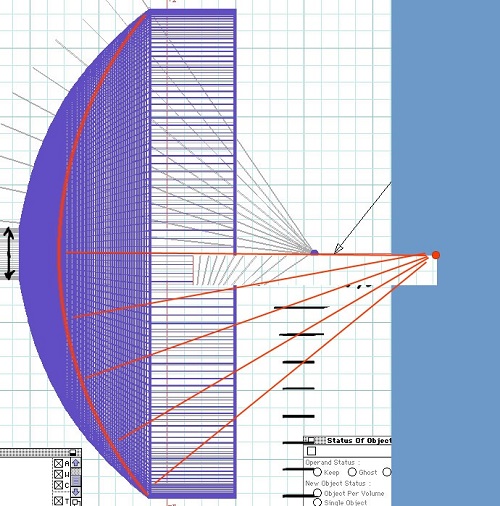
Mechanical Engineering
Very smart, it turns out.
As we explained in Shipstar:
We supposed the founders made its understory frame with something like scrith–a Ringworld term, greyish translucent material with strength on the order of the nuclear binding energy, stuff from the same level of physics as held Ringworld from flying apart. This stuff is the only outright physical miracle needed to make Ringworld or the Bowl work mechanically. Rendering Ringworld stable is a simple problem—just counteract small sidewise nudges. Making the Bowl work in dynamic terms is far harder; the big problem is the jet and its magnetic fields. This was Benford’s department, since he published many research papers in Astrophysical Journal in the like on jets from the accretion disks around black holes, some of which are far bigger than galaxies. But who manages the jet? And how, since it’s larger than worlds? This is how you get plot moves from the underlying physics.
One way to think of the strength needed to hold the Bowl together is by envisioning what would hold up a tower a hundred thousand kilometers high on Earth. The tallest building we now have is the 829.8 m (2,722 ft) tall Burj Khalifa in Dubai, United Arab Emirates. So for Ringworld or for the Bowl we’re imagining a scrith-like substance 100,000 times stronger than the best steel and carbon composites can do now. Even under static conditions, though, buildings have a tendency to buckle under varying stresses. Really bad weather can blow over very strong buildings. So this is mega-engineering by master engineers indeed. Neutron stars can cope with such stresses, we know, and smart aliens or even ordinary humans might do well too. So: let engineers at Caltech (where Larry was an undergraduate) or Georgia Tech (where Benford nearly went) or MIT (where Benford did a sabbatical) take a crack at it, then wait a century or two—who knows what they might invent? This is a premise and still better, a promise—the essence of modern science fiction.
Our own inner solar system contains enough usable material for a classic Dyson sphere. The planets and vast cold swarms of ice and rock, like our Kuiper Belt and Oort Clouds—all that, orbiting around another star, can plausibly give enough mass to build the Bowl. For alien minds, this could be a beckoning temptation. Put it together from freely orbiting sub-structures, stuck it into bigger masses, use molecular glues. Then stabilizes such sheet masses into plates that can get nudged inward. This lets the builders lock them together into a shell–for example, from spherical triangles. The work of generations, even for beings with very long lifespans. We humans have done such, as seen in Chartres cathedral, the Great Wall, and much else.
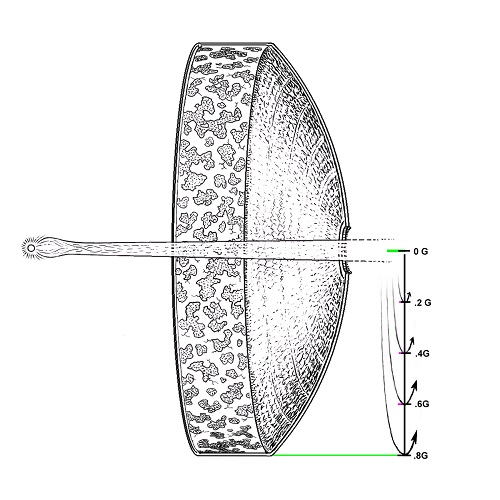
Origins
Still: Who did this? Maybe the Bowl was first made for just living beneath constant sunshine. Think of it as an interstellar Florida, warm and mild, with a fantastic night sky. Which keeps moving, over time.
At first the builders may have basked in the glow of their smaller sun, developing and colonizing the Bowl with ambitions to have a huge surface area with room for immense natural expanses. But then the Bowl natives began dreaming of colonizing the galaxy. They hit on the jet idea, and already had the Knothole as an exit for it. Building the mirror zone took a while, but then the jet allowed them to voyage. It didn’t work as well as they thought, and demanded control, which they did by using large magnetic fields.
The system had virtues for space flight, too. Once in space, you’re in free fall; the Bowl mass is fairly large but you exit on the outer hull at high velocity, so the faint attraction of the Bowl is no issue. Anyone can scoot around the solar system, and it’s cleared of all large masses. (The Bowl atmosphere serves to burn any meteorites that punch through the monolayer.)
The key idea is that a big fraction of the Bowl is mirrored, directing reflected sunlight onto a small spot on the star, the foot of the jet line. From this spot the enhanced sunlight excites a standing “flare” that makes a jet. This jet drives the star forward, pulling the Bowl with it through gravitation.
The jet passes through a Knothole at the “bottom” of the Bowl, out into space, as exhaust. Magnetic fields, entrained on the star surface, wrap around the outgoing jet plasma and confine it, so it does not flare out and paint the interior face of the Bowl — where a whole living ecology thrives, immensely larger than Earth’s area. So it’s a huge moving object, the largest we could envision, since we wanted to write a novel about something beyond Niven’s Ringworld.
For plausible stellar parameters, the jet can drive the system roughly a light year in a few centuries. Slow but inexorable, with steering a delicate problem, the Bowl glides through the interstellar reaches. The star acts as a shield, stopping random iceteroids that may lie in the Bowl’s path. There is friction from the interstellar plasma and dust density acting against the huge solar magnetosphere of the star, essentially a sphere 100 Astronomical Units in radius.
So the jet can be managed to adjust acceleration, if needed. If the jet becomes unstable, the most plausible destructive mode is the kink – a snarling knot in the flow that moves outward. This could lash sideways and hammer the zones near the Knothole with virulent plasma, a dense solar wind. The first mode of defense, if the jet seems to be developing a kink, would be to turn the mirrors aside, not illuminating the jet foot. But that might not be enough to prevent a destructive kink. This has happened in the past, we decided, and lives in Bowl legend.
The reflecting zone of mirrors is defined by an inner angle, ?, and the outer angle, ?. Reflecting sunlight back onto the star, focused to a point, then generates a jet which blows off. This carries most of what would be the star’s solar wind, trapped in magnetic fields and heading straight along the system axis. The incoming reflected sunlight also heats the star, which struggles to find an equilibrium. The net opening angle, ? minus ?, then defines how much the star heats up. We set ? = 30 degrees, and ? = 5 degrees, so the mirrors subtend that 25 degree band in the Bowl. The Bowl rim can be 45 degrees, or larger.
The K2 star we gave the Bowl is now running in a warmer regime, heated by the mirrors, thus making its spectrum nearer that of Sol. This explains how the star can have a spectral class somewhat different from that predicted by its mass. It looks oddly colored, more yellow than its mass would indicate.
For that matter, that little sun used to be a little bigger. It’s been blowing off a jet for many millions of years. Still, it should last a long time. The Bowl could circle the galaxy itself several times.
The atmosphere is quite deep, more than 200 km. This soaks up solar wind and cosmic rays and makes the Bowl toasty through greenhouse effect. Also, the pressure is higher than Earth normal by about 50%, depending on location in the Bowl. It is also a reservoir to absorb the occasional big, unintended hit to the ecology. Compress Earth’s entire atmosphere down to the density of water and it would only be 30 feet deep. Everything we’re dumping into our air goes into just 30 feet of compressed nitrogen and oxygen, then. The Bowl has much more, over a hundred yards deep in equivalent water. Too much carbon dioxide? It gets more diluted.
This deeper atmosphere explains why in low-grav areas surprisingly large things can fly–big aliens and even humans. We humans Earthside enjoy a partial pressure of 0.21 bars of oxygen, and we can do quite nicely in a two-bar atmosphere of almost pure oxygen (but be careful about fire). The Bowl has a bit less than we like: 0.18 bar, but the higher pressure compensates. This depresses fire risk, someone figures out later.
Starting out, we wrote a background history of where the Builders came from, which we didn’t insert into the novel. It lays out a version of what made the Builders do all this.
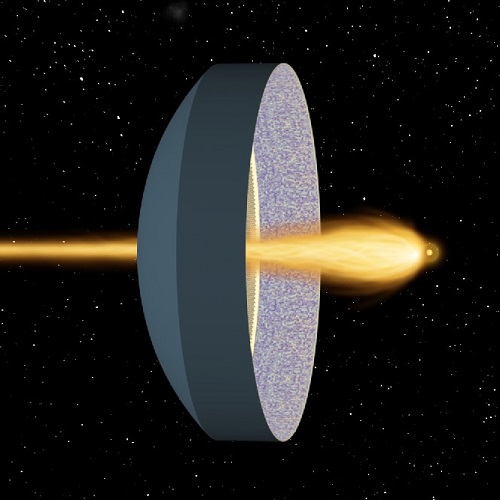
Is this plausible?
Not really. It demands the scrith, for example, which nobody knows how to make.
And the Bowl is a vast accident waiting to happen. You can’t just say Don’t blame me, it’s nonlinear. Somebody has to manage that jet forever. The natives get to take part in slow-motion starflight, but they’re always in danger. Their society must keep this from being obvious, or they’d all go crazy.
Our goal in writing the two novels, and perhaps stories to follow, was to show how strange an alien mindset could be, by giving it a real, physical presence, in the Bowl. Also, we wanted to see what it felt like to think of where humanity itself might go, given time, purpose, and the true essential, imagination.
© 2014 by Gregory Benford

Stars as Stellar Engines
I’ve always loved the idea of an O’Neill space habitat because of the possibility of engineering a huge environment to specification. That notion translates well to worldship ideas — a multi-generational journey would certainly be easier to take in an environment that mimicked, say, a Polynesian island, than aboard something more akin to a giant metal barracks. But best of all is to take your environment with you, which is why the thought of moving entire stars and planets to another location has such appeal when we’re talking on an intergalactic scale.
Adam Crowl reminded us of the possibilities on Monday:
In theory a tight white-dwarf/planet pair can be flung out of the Galactic Core at ~0.05c, which would mean a 2 billion year journey across every 100 million light-years. A white-dwarf habitable zone is good for 8 billion years or so, enough to cross ~400 million light-years. It’d be a ‘starship’ in truth on the Grandest Scale.
Back in November of 1973, Stanley Schmidt’s The Sins of the Fathers began as a three-part serial in Analog, then under the editorship of Ben Bova, who had taken over after the death of John Campbell in 1971. Schmidt would go on to become Analog‘s editor himself in 1978, only retiring recently, so that his own tenure at the magazine matched Campbell’s long run. The Sins of the Fathers would be published as a paperback in 1976 with a cover by the brilliant SF artist Richard Powers. Lifeboat Earth would continue the journey in the Berkeley paperback of 1978.

Schmidt’s plan was to make an intergalactic crossing to M31, the Andromeda Galaxy, with the help of alien technologies. The plot involves an explosion in the core of the galaxy on such a scale that planets will be rendered uninhabitable throughout the Milky Way. Fortunately, an alien race called the Kyrra has arrived to help, equipping the Earth with what Schmidt called an ‘induced annihilation’ drive that converts matter to energy without the need for antimatter. With this gigantic rocket nozzle mounted at the South Pole, the Earth is nudged out of its orbit, at which point the Kyrra’s FTL technology (Schmidt calls this the Rao-Chang drive) cuts in.
Of course, the effects of maneuvering the planet in this way are substantial. Schmidt explained them in an article called “How to Move Planet Earth,” which ran in the May, 1976 issue of Analog, after the serialization of his novel was complete. Here’s a bit of this:
Perhaps the most immediately striking of these [effects] is to change the effective ‘up-down’ direction. To a person standing on what had been a level plain (or floor or ocean), the appearance and feel of this is exactly as if the Earth were tilting under his feet. All over the Earth, the ground appears to slope downward to the south. The amount of tilt, and the strength of the effective field, vary with latitude… One of the first globally important consequences of this effective tilting will be a tendency for the oceans and most of the atmosphere to flow ‘downhill’ and concentrate (to such extent as they aren’t blasted or blown away) at and near the South Pole.
And so on. Schmidt works through all the consequences in the article, which recounts his valiant attempt, having plugged in magical alien technologies, to work out their physical effects according to known physics. Surely he was smiling when he wrote: “But these things — the Rao-Chang, induced annihilation, and exhaustless conversion process, together with their logical implications — are the only really new physics I have assumed.” I love that ‘only’! In any case, the journey is a nightmare, with the alien technologies consuming what Earth resources they haven’t already destroyed in the propulsion process, so that by the time our battered world gets to M31, the few survivors must get off the planet and onto another one.
Robert Metzger, who for years wrote the science column in the Science Fiction Writers of America’s Bulletin, wrote a novel called Cusp (Ace, 2005) in which the Sun erupts with a massive, propulsive jet and begins a journey of its own, with the Earth suddenly encircled by enormous ring-like structures that help propel it along with the parent star. Here we’re in the company of quantum supercomputers (the ‘CUSP’ of the title) and technologies evolving into the Singularity so often speculated about in science fiction and elsewhere. Needless to say, the physical effects of moving the planet and star are as acute as they are in Schmidt’s novel.
In Bowl of Heaven (Tor, 2012), Gregory Benford and Larry Niven looked at ways to move an entire star to travel the galaxy — the sequel, ShipStar is just out (Tor, 2014), and nearing the top of my stack. Imagine half of a Dyson sphere curved around a star whose energies flow into a propulsive plasma jet that moves the entire structure on its journey. Here the notion of living space may remind you of Niven’s Ringworld, that vast structure completely encircling a star, though not enclosing it. The difference is that in the ShipStar scenario, most of the ‘bowl’ is made up of mirrors, with living space just on the rim.
I see the ShipStar model as a modified Shkadov thruster, a way of moving entire stars that the physicist Leonid Shkadov first described in 1987. In both cases, we’re talking about what can be called ‘stellar engines’ that use the resources of the star itself to create their propulsion. Would such a vast structure be detectible by another civilization? As with Dyson spheres, the size of the objects makes it feasible to consider picking them up in exoplanet transit data. Scottish physicist Duncan Forgan has considered the transit signature of a Shkadov thruster. As with the work of Richard Carrigan, the man whose searches for Dyson spheres have helped to define ‘interstellar archaeology,’ the Shkadov thruster could play a role in future SETI searches.
As is true of all such searches, we have to determine whether what we are seeing is fully explicable in terms of natural phenomena or whether there is a case to be made for technology, and I would rate the chances of our finding a Shkadov thruster quite low. But searching for artifacts in our existing astronomical databases is clearly a worthwhile idea. Certainly a civilization that had the power to move a star might find it a livable way to embark upon journeys lasting millennia. In such ways, a trip to another galaxy is not inconceivable even if tens of thousands of generations might live and die along the way. The key question: What compelling reasons might drive such a journey?
What I haven’t had the chance to get to today are astronomer Fritz Zwicky’s ideas on moving stars, an omission I’ll try to rectify next week. The Forgan paper mentioned above is “On the Possibility of Detecting Class A Stellar Engines Using Exoplanet Transit Curves,” accepted for publication in the Journal of the British Interplanetary Society (preprint). Leonid Shkadov’s paper on Shkadov thrusters is “Possibility of controlling solar system motion in the galaxy,” 38th Congress of IAF,” October 10-17, 1987, Brighton, UK, paper IAA-87-613.

Intergalactic Travel via Hypervelocity Stars
We’ve been looking at not just interstellar but intergalactic crossings in the past few days, something of an homage to Carl Sagan, whose enthusiasm for continuous acceleration at 1 g and relativistic time dilation was immense in the years shortly after Robert Bussard’s key paper on interstellar ramjets. Without a working ramjet and largely unaided by time dilation, we’re faced with millions of years of flight time to reach M31. What to do?
In a recent paper, discussed here by Adam Crowl on Monday, Robin Spivey ponders ‘autonomous probes that spawn life upon arrival’ as a way of reaching the Virgo cluster, which he wants to do for reasons Adam explained in his post. He’s also counting on continuous acceleration at 1 g for these small ‘seed ships,’ but other than mentioning antimatter, he doesn’t explore how this would be done, and we’ve seen the results Sagan and Iosif S. Shklovskii came up with for antimatter when they worked out the equations.
Let’s assume that the ‘slow boat’ solution is the only practical way to proceed. Here I think Adam’s suggestion that we take our environment with us rather than building a worldship is sensible, flinging a small star and planet out of the galactic core toward the destination. Ray Villard pondered the same question back in 2010 in an online piece called The Great Escape: Intergalactic Travel is Possible. He points to the four million solar mass black hole at the center of the Milky Way as the only conceivable way to impart the needed kinetic energy to a star.
Here’s how Villard describes the mechanism:
The theory is that a star could be slingshot out of a binary star system if the stellar duo swung close to the central black hole. The hole’s gravitational tidal forces would break apart the pair’s gravitational embrace.
The companion star orbiting in the direction of the black hole would pick up momentum and plunge toward the black hole. In accordance with Newton’s third law of motion — action-reaction — the other binary companion would go whizzing off with the same velocity but opposite direction away from the black hole.
In just a few thousand years the star would ascend out of the galactic plane and hurtle deep into intergalactic space. The persistent tug of our Milky Way’s dark matter halo would slow it down but the star would never fall back into the Galaxy.
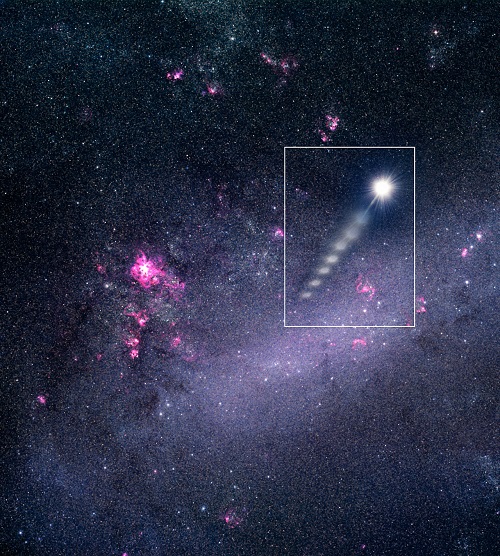
Image: Using ESO’s Very Large Telescope, astronomers have recorded a massive star moving at more than 2.6 million kilometres per hour (1160 km/sec). Credit: ESO.
We do in fact know about a number of such hypervelocity stars, some of which may be moving fast enough to exceed galactic escape velocity. Consider this: Ordinary stars in the Milky Way have velocities in the range of 100 kilometers per second, while some hypervelocity stars near galactic center show velocities of ten times that, closing on 1000 km/sec. Meanwhile, a team led by Tilmann Piffl (Leibniz Institute for Astrophysics, Potsdam) that has been working with high-velocity stars has calculated escape velocity for objects in the vicinity of our own Solar System. The team uses data from the Radial Velocity Experiment (RAVE) survey.
The result: We would need 537 kilometers per second to get our payload fast enough to escape the galaxy. That’s a high speed, of course, but in terms of small craft, it’s not a lot higher than some studies have shown a solar sail could reach using an extremely tight ‘Sundiver’ maneuver to let itself be whipped out of the Solar System. Piffl’s team has catalogued hypervelocity stars moving at 300 km/sec, and we also know of unbound hypervelocity stars (although it’s a tricky call because of uncertainties about the mass distribution of the galaxy). Even some neutron stars are fast-movers: RX J0822-4300 was measured to move at 1500 km/sec in 2007.
Not all hypervelocity stars come from encounters with the black hole at galactic center. In work described at the American Astronomical Society meeting in January, Kelly Holley-Bockelmann and grad student Lauren Palladino found what may be a new class of hypervelocity stars moving with sufficient speed to escape the galaxy (see Stars at Galactic Escape Velocity). Says Holley-Bockelmann:
“It’s very hard to kick a star out of the galaxy. The most commonly accepted mechanism for doing so involves interacting with the supermassive black hole at the galactic core. That means when you trace the star back to its birthplace, it comes from the center of our galaxy. None of these hypervelocity stars come from the center, which implies that there is an unexpected new class of hypervelocity star, one with a different ejection mechanism.”
As we learn more about what creates hypervelocity stars, can we imagine far future technologies that might help us exploit them? If so, an intergalactic journey opens up. A civilization that somehow harnessed a hypervelocity star for such a journey — or one that arose on a planetary system that had been already flung into intergalactic space — would experience eons in the space between the galaxies, periods that dwarf the lifetime of human civilizations. Villard speculates about the astronomers of such a civilization trying to discover their place in the universe as their ‘worldship’ exited the Milky Way, globular clusters peppering the sky, the galaxy’s spiral arms winding out from a nucleus looking like ‘a fuzzy headlamp.’
Inevitably larger telescopes would yield a view of the universe that revealed myriad other pinwheel structures. Spectroscopy would show they are racing away too. Still the aliens literally wouldn’t know if they’re coming or going. A long-lived civilization’s science archive would note the shrinking and dimming of the Milky Way over geologic time. They might conclude that the eerie pinwheel is speeding away from them. And without a cosmological or stellar framework, they would have no idea of cosmic evolution. They would not even be able to calibrate the vast distance to the Galaxy.
But let’s assume for the sake of argument that a civilization might knowingly set out on a hypervelocity star system, its futuristic powers vast enough to shape the encounter between the star and the galactic black hole so as to direct its journey to the proper destination. Any culture that did this would knowingly be splitting into different evolutionary lines given the immensity of the distances and time involved, leaving behind its own species to grow into another over the course of millions of years. Whether and why any species might choose to make this kind of a journey is an exercise left to the reader, and to the imagination of science fiction writers.
We’ve seen stars manipulated for a variety of purposes in science fiction, as a matter of fact. Tomorrow I’ll wrap up this week of speculations on intergalactic travel with a look at some of the methods that have been employed to move stars around, and the possible SETI implications that arise from all this.
The Piffl paper is “The RAVE survey: the Galactic escape speed and the mass of the Milky Way,” submitted to Astronomy & Astrophysics (preprint). The Palladino paper is “Hypervelocity Star Candidates in the SEGUE G and K Dwarf Sample,” The Astrophysical Journal Vol. 780, No. 1 (2014), with abstract and preprint available.


